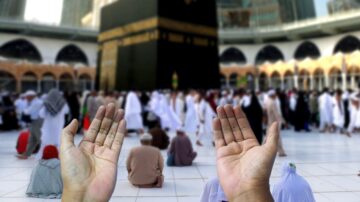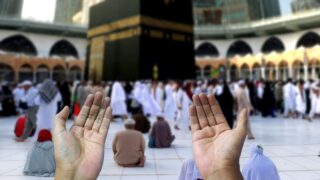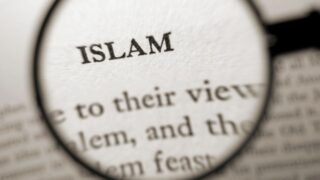The moon is the earth’s dark satellite, visible only by reflecting the light of the sun. The visible area of the moon changes daily according to the angle formed by line between the sun, the earth and the moon, which results in the cycle of lunar phases.
The Islamic calendar is based on this natural phenomenon, which is used to determine the beginning of each lunar month in compliance with the Qur’an (2:189), “They ask thee about the new moons. Say, ‘they are but signs to mark fixed points of time for people [to manage their affairs], and [to identify the time of] hajj.’” Of particular concern to Muslims are the beginnings of the fasting month of Ramadan and the month of hajj, the pilgrimage season. The first day of the lunar month is identified by the sighting of the waxing crescent, after sunset on the twenty-ninth or the thirtieth day of the foregoing month.
Everywhere in the Muslim world, sighting the waxing crescent is important. In addition to setting the calendar, it also determines the dates of important religious occasions. But sighting the crescent has always been a controversial issue in the Islamic world. In some places, it can be spotted easily whereas in others it may not be. There have been incidents of inaccurate sighting reports. Such incongruities call for more efforts on the part of Muslim astronomers to put an end to differences in this regard.
The moon, like the planets, has a slightly elliptical orbit. To determine its apparent position, particularly as a waxing crescent, several measurements have to be made including its distance from the sun, its position in relation to a specific observer on earth, and the exact time of its rising and setting.
Detailed tabular calculations of the motion of the moon were produced in the nineteenth century by the British-born American mathematician and astronomer, Ernest William Brown. These tables were later improved by twentieth century astronomers who developed equations to determine the exact position of the moon.
Muslim astronomers, proceeding from Kepler’s laws, have developed computer software to identify the position of the earth in its orbital movement round the sun. The point is to determine accurately the time of sunset and, consequently, the exact position of the crescent using the equations derived from Brown’s lunar tables.
Muslim astronomers known for their work on calculating the lunar months include, most notably, Al-Battani (850-929), Al-Bayrouni (973-1048) and Nassir al-Din Al-Tousi (1258-1274). In the nineteenth century, an Egyptian army general, Mohamed Mokhtar Pasha (1846-1897), produced a valuable work on tabular correlations of the Muslim calendar, the Gregorian calendar and the ancient Middle Eastern luni-solar system of time reckoning. The tables cover the Muslim calendar from years 1 through 1500 and the matching dates under the other two systems.
According to Islamic Shari’a, to establish the beginning of the new lunar month, the crescent must be sighted by the naked eye under specific conditions. The sighting may, however, be influenced by a number of factors including:
– the life-length of the crescent, and the angle it forms with the sun.
– the height of the crescent relative to the horizon line at the time of sunset.
– the distance between the earth and the moon.
– weather conditions and the degree of visibility.
The first two factors are essential. The third is partially important, since the distance between the earth and the moon changes by approximately ± 4%, which has a negligible effect on visibility. The fourth factor depends on variable local conditions at the time of sighting the crescent.
The following two conditions for sighting the crescent were set by the Fiqh (Muslim jurisprudence) committee of the Islamic Conference held in Istanbul in 1978:
– The angle of the crescent’s position above the horizon at sunset must be at least 5 arc degrees;
– The angle formed by the moon and the sun must be at least 8 arc degrees.
When these two most essential conditions are fulfilled, the following day shall be the first day of the new month.
The motion of the moon can now be calculated with great precision, but the beginning of every new lunar month remains a problem. Surveys will have to be conducted in various places in the Islamic world for several years to allow for sufficient statistical analysis. If this is done, differences between Muslim countries in marking religious occasions may be finally overcome.
Whenever faced with two or more options, Prophet Muhammad (SAW) always chose the one that was most accessible to his faithful followers. The Qur’an (9:128) describes him as being extremely commiserating and willing to spare the Muslims suffering and hardship. The Qur’an (2:185) also tells us that God intends every facility for the faithful, and does not will that they be put to unaffordable tasks in life. Islamic Shari’a was therefore satisfied with what was within the means of the Prophet’s companions. This, however, does not mean that recently developed scientific methods are to be excluded. This seemingly contradiction of views calls for a closer look.
Early Muslim scholars were almost unanimous on rejecting astronomical methods during their time because, to them, there was no clear line of demarcation between astronomy and astrology. However, modern astronomy is different. It draws on spherical geometry and celestial mechanics, two modern branches of science that enabled man to land on the moon over a quarter of a century ago.
According to Dr. Mostafa Al-Zarqa, a leading Muslim scholar, the debate on the legitimacy of astronomical calculation is the greatest oddity in modern jurisprudence, remaining hot at a time when man has navigated the vast expanses of the universe, and landed on the moon. At the present time, landing on the moon is no longer considered a great feat.
All relevant Hadith suggest that sighting the moon with the naked eye was the only method available back then because the majority of the Muslim population was illiterate. This by no means excluded verifiable scientific methods that are capable of yielding extremely accurate results. The naked-eye method is perfectly acceptable when conditions of clear visibility are available. Otherwise, there is no reason why scientific calculations should not be relied upon. It is a shame that there is sometimes a three-day discrepancy between Muslim countries in deciding the beginning and the end of Ramadan.
The position of early Muslim jurisprudents to reject guessing and intuition as sources of reliable knowledge on this particular issue is understandable. Astronomy was far from developed at that early stage of Islam, Al-Zarqa explains.
The Fatwa (Muslim religious opinion) House in Egypt has recently decided that the naked-eye sighting method is the standard method of establishing the beginning and the end of lunar months. Astronomical measurements, the House says, may be used only as a supportive tool, not as an alternative. But sighting reports that contradict accurate measurements must be rejected because Islam exhorts its followers to resort to the proper channels of learning and knowledge.
Meanwhile, with the approach of every new Ramadan, the same controversy around deciding its first and last days is renewed. Muslim countries continue to begin and end Ramadan on different days, and to celebrate other important religious occasions on different days because of a lack of coordination and standardization…
By Dr. Musallam Shaltout

















